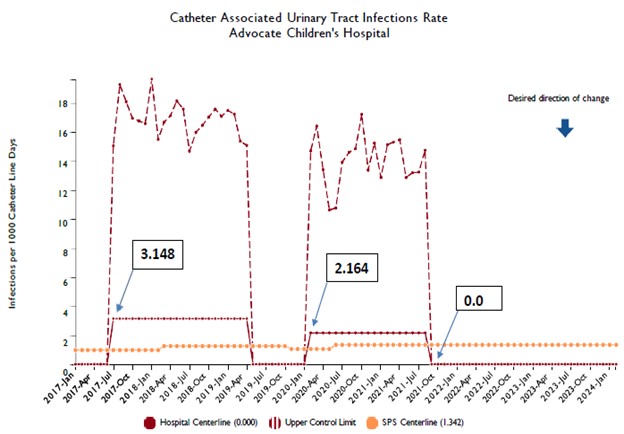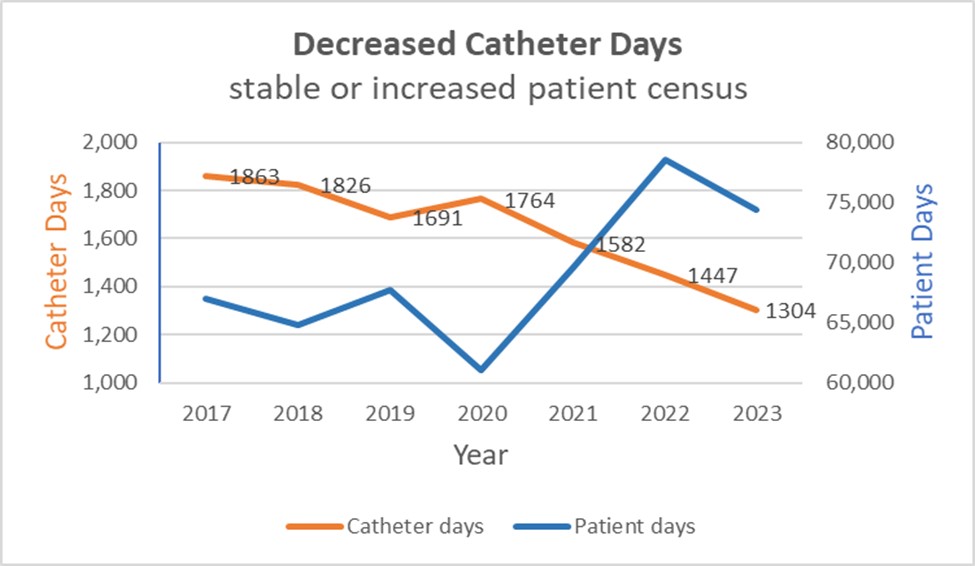Quality Improvement/Patient Safety 5
Session: Quality Improvement/Patient Safety 5
470 - Achieving and Maintaining Zero CAUTI for Over One Year
Saturday, April 26, 2025
2:30pm - 4:45pm HST
Publication Number: 470.3979
Theresa He, Advocate Children's Hospital - Oak Lawn, Chicago, IL, United States

Theresa He, MD (she/her/hers)
Vice President, Quality and Safety
Advocate Children's Hospital - Oak Lawn
Chicago, Illinois, United States
Presenting Author(s)
Background: We are a bi-campus children’s hospital within two adult hospitals. Our pediatric patients travel throughout the clinical units and between shared service areas with adult patients. We identified catheter associated urinary tract infections (CAUTI) as one of our key focus areas for 2022-2024 goal period. Our longest stretch of no CAUTI events had been 10 months. Our CAUTI team was striving for a goal of zero CAUTI in 2023.
Objective: We aimed to reduce our number of CAUTI across both campuses by 50% during the 2022-2024 goal period. We identified opportunities for improvement within our multidisciplinary clinical teams to achieve the zero CAUTI goal. Our focus was on high-risk patients who are at most risk for CAUTI.
Design/Methods: We implemented a multidisciplinary bedside huddle every 12 hours to discuss necessity of the indwelling urinary catheter. We focused on nursing empowerment and innovation with high-risk patients. We partnered with the urology team to enhance our knowledge of the specialized patient population. The CAUTI team identified opportunities to enhance infection prevention and created new job aids to support the CAUTI bundle. Our CAUTI champions reviewed job tools with frontline team members to reinforce compliance with the evidence-based bundles of care. Interrater reliability was completed with all unit auditors for bundle compliance.
Results: We have had zero CAUTI for over a year across both campuses of our children’s hospital. Our CAUTI center line have shifted down with decreased rates over time periods (figure 1a and 1b). We have seen a 30% reduction in our catheter device days on average, despite stable or increased patient census (figure 2). We have consistent high reliability with our insertion and maintenance audits.
Conclusion(s): Increased communication between the multidisciplinary teams has driven real-time interventions at the bedside. Our team members feel empowered to discuss urinary catheters and initiate conversations to remove the urinary catheter when indicated. Discussions now include alternatives to indwelling catheters and use of straight catheters to reduce catheter device days. These multidisciplinary interventions are now hardwired in the setting of a positive safety culture and have helped us to achieve zero CAUTI.
Figure 1a. Shifts down of CAUTI center line

Figure 1b. CAUTI rate by time periods

Figure 2. Reduction in urinary catheter device days despite increasing volumes



